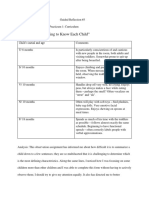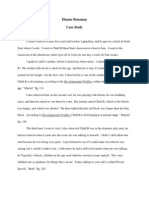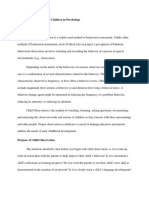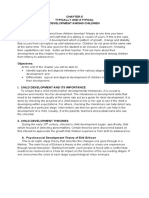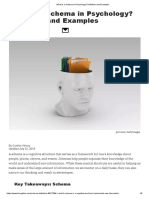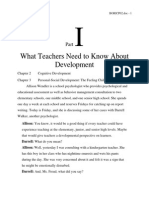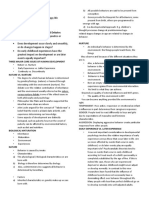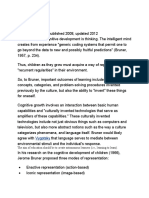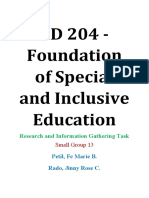Running head: CLINICAL OBSERVATION 1
Clinical Observation Paper
Grier Bethea
Coastal Carolina University
EDEC 332-01
Dr. Megan McIlreavy
December 6, 2019
�CLINICAL OBSERVATION 2
Clinical Observation Paper
For the focus of this clinical observation, I chose one male and one female student from a
class of seventeen preschoolers at Green Sea Head Start. Throughout the course of an eight-week
observation, I was able to gain an understanding of each child’s developmental progress. Child A
is an African American male who was born on December 1, 2014. He is the eldest of three
children in his household. Both his mother and father, as well as his two siblings, reside with him
in Green Sea, South Carolina. Overall, Child A is well developed physically and cognitively, but
is behind social emotionally. Child B is an African American female who was born on December
22, 2014. She currently lives in Green Sea, South Carolina with her mother, stepfather and
younger sister. Her mother is also expecting another baby girl in a few months. Child B’s
development is advanced cognitively, and she is on target social emotionally and physically. I
have included specific information about each child’s social emotional, cognitive, and physical
development related to their completion of age-appropriate tasks that I observed.
Child A has exhibited the development of some social emotional skills, but all of the
milestones have not been met. He enjoys playing with other children, singing and dancing, and is
talkative. He often participated in family role-play in the dramatic play center and was creative in
his interactions. I observed him communicating effectively with the children and teacher and he
was often demanding of his needs. However, his demandingness frequently interfered with his
ability to control his emotions. On multiple occasions, I observed child A interacting in the
dramatic play center with his friends. In that center, there was money for the children to use
when they play grocery store. Child A took the money seriously and always wanted it all. One
day, child A entered the dramatic play center to find that another student had all of the money.
Immediately, he demanded that the other child give him the money. The other child willingly
�CLINICAL OBSERVATION 3
shared some of the money with him, but he still kept some for himself. So, child A got extremely
angry and began yelling, hitting and throwing things. He was removed from the area and the
money was taken away. However, he was not able to gain control of his emotions until all of the
children left the room to go play outside. Behaviors similar to the example were frequent and
progressively got worse throughout the course of my observations.
Child B’s social emotional development skills are on target. She has a bubbly personality
that allows her to play well with her peers and communicate effectively with adults. When she
makes art in the art center, she is enthusiastic about her work and wants the teachers to see it.
One day, she drew a bunny and very excitedly came to show me, the other CCU teacher
candidate, the assistant teacher, and the teacher. She also loves playing “mama” in the dramatic
play center. Her interactions within this center are very imaginative and cooperative with others.
When playing the role of “mama,” she would cook, hold a baby, feed her “children”, and talk on
the phone. I observed another child tell child B that she should cook spaghetti instead of
hamburgers, and child B was cooperative with the change. However, if something in the
classroom does upset her, she is able to manage her emotions well. On one occasion, child B was
upset because another child was touching her. She told her teacher, and her teacher instructed her
to, “use your words and tell the child that you don’t like it when he touches you.” Child B used
her words and told the child, and she was not upset anymore.
When observing the cognitive level of child A, I saw evidence of many developmental
milestones that suggest his abilities in this area. He can recite numbers, letters and colors. He can
independently write his name and he can write most letters of the alphabet with support. During
one observation, I was playing with child A in the block center while he was building a tower of
blocks. I asked him how many blocks were in his tower; he counted them up, and told me, “12.”
�CLINICAL OBSERVATION 4
This answer was correct, but I have also heard child A count up to 30 correctly. Furthermore,
child A is good at puzzles; so much so that he often gets frustrated when watching other children
do them because they do not solve them fast enough. Child A understands time and knows his
schedule accordingly. As he entered the classroom on one occasion, he asked his teacher when
the class would be doing a specific activity and she told him that it would be that afternoon. He
replied and asked her, “so after nap time?” and she told him yes. He was aware that it was
currently morning, and that the afternoon is when nap time is.
Child B has stellar cognitive abilities. Because of her outgoing personality, I found it
particularly easy to observe her level of cognitive development. Conversations with her were
more sophisticated than with that of the other children. She typically used longer sentences and
was very curious. On a couple occasions, she asked me if I knew her mom’s and her sister’s
name. I did not know them, but she told me, and expected me to remember the next visit. After
read aloud instruction in the classroom, the teacher would ask about different parts of the story
and child B contributed to the conversation accurately every time I was there. One day, the
teacher read a book about five different farm animals. Child B was able to tell the teacher that
there were goats, chickens, cows, horses and pigs in the story and that they all lived on a farm.
During art center, I noticed that she was able to name each available color correctly. She
specifically asked her teacher for the green crayon and the brown crayon when she was drawing
a picture of her house. Child B could also recite all of the letters in the alphabet and I observed
her counting with ease up to 50.
Child A is physically well developed for his age. Both his gross and fine motor
development skills are exemplary. He is one of the tallest children in the class, is very athletic,
and enjoys recess. His coordination allows him to move through physical tasks effortlessly.
�CLINICAL OBSERVATION 5
During recess time, I observed his gross motor skills. He was running with friends in a pretend
game of football, throwing and catching the football with accuracy, climbing on the playground
equipment, skipping, and hopping. I specifically looked for the developmental milestone of
swinging. While swinging was often not his first pick at recess, he could swing and even got
called down by the teachers for swinging too high. Child A is also on target when it comes to
fine motor skills. During my observations, he showed dominance of his right hand. He zipped
and unzipped his own pants and coat, buttoned and unbuttoned his pants, tied his shoes, and used
a fork and spoon correctly to eat. His progress in fine motor skill development also helps him
excel in the classroom. I observed him coloring with control, using scissors to cut, and writing
his name. During one particular activity in the class when students had to color, cut, and paste, he
was the first one to finish. I observed his skills throughout this activity and his coloring was
controlled and mostly in the lines, he properly held the scissors and cut relatively straight, and he
used the glue efficiently to paste the pieces together. He was also able to write his name legibly
with a pencil on a piece of paper, which was a skill that progressively developed over the course
of my observations.
Similarly, child B is physically well developed in both her gross and fine motor skills.
Her interests are more in activities involving fine motor skills, so she is more developed in that
area. However, she is the average size for a female her age and her gross motor skills are
developing normally. During my observations at recess, I saw her running and chasing her
friends, playing hopscotch, and climbing on the playground equipment. I specifically noticed,
however, that each time she got on the swing, she wanted someone to push her. This factor may
suggest that she is not completely meeting the physical development milestones for her specific
age. I was also able to observe fine motor skills at recess. A couple of the days that I was there,
�CLINICAL OBSERVATION 6
she would draw the hopscotch game on the concrete using sidewalk chalk. Inside the classroom,
her favorite activities were in the art station. Child B showed interest in painting, drawing,
cutting and pasting, and molding clay. When completing these tasks, she showed dominance to
her left hand. During one observation, she painted an accurate representation of the beach,
including sand, water and the sun. In other observations, she correctly held the scissors and
writing utensils, manipulated the modeling clay using play knifed and cookie cutters, and wrote
her name legibly using pencils and paper. I also observed her fine motor development skills to
complete functional tasks such as using a fork and spoon to eat, opening her milk, tying her
shoes and zipping and buttoning her pants.
Developmental psychologist, Jean Piaget, did much research on how children learn and
construct knowledge about the world around them. He developed a four-stage theory of cognitive
development. The stages describe the development of thought from the time of birth into
adulthood. For this project, the focus was on the preoperational stage. This stage is typically
from age two-seven and is characterized by egocentrism and symbolic thinking (McLeod, 2018).
Both child A and child B showed egocentric actions. Child A had trouble sharing, as he could not
see the perspective of his peers. In the discovery center, his friend was playing with magnets
while child A was building something. Child A decided that he needed the magnet for his
building, so he took it from his friend. When the teacher instructed child A to give the magnet
back, he got very upset and began crying. Child B, on the other hand, is egocentric in that she
thinks she is the best. In the art center, she told her friend that his butterfly painting was not as
good as hers. She told him that only she could paint a good butterfly. As a part of Piaget’s
research of children, he performed various conservation tasks. He said that children in the early
preoperational period would fail on every task, but children in the late preoperational period
�CLINICAL OBSERVATION 7
would succeed at some (Morgan, 2019). I decided to perform the conservation of mass task on
child A and B. The conservation of mass task involves using play dough to mold to very similar
balls, asking the children to agree that they are equal, then rolling one ball out into a sausage-like
shape, and asking them which has more. Piaget says that children in early preoperational period
will say that the sausage-like figure has more, when in reality, they are still equal. I chose to do
this specific task because play dough was readily available in the classroom. Not surprisingly,
when I tested child A and B, they both said that the sausage-like shape was larger. Child A was
very confident in his answer. Child B said that the sausage-like shape was larger because it was
“fatter.”
Similar to Piaget, Erik Erikson’s theory of development is based on a stage model. His
theory, however, is focused on psychosocial development. There are eight stages total, but the
stage relevant to the children of study is stage three, initiative vs. guilt. In this stage, children
either feel the urge to initiate activities, or if adults do not allow that, they develop a sense of
guilt. Successful children will have a healthy balance of initiative to explore and lead on their
own, with some guilt to exercise self-control (McLeod, 2018). Based on my observations of the
adult influence of the teachers in the classroom, they encouraged initiative in the children. The
children were given many opportunities to lead and explore through a variety of play options and
involvement in classroom instruction. Specific to the children of observation, they both had
initiative. Child A was completely initiative-driven, with very little guilt. In the classroom, I
often observed him being the “ringleader” of activities. Whether the activities that he came up
with were creative and inventive, or mischievous and unfavorable, the other children in the class
would follow him. For example, one day, child A came up with a farm game that many students
played in and enjoyed at centers. However, that same day, he also gathered all of his friends and
�CLINICAL OBSERVATION 8
led them to take toys that the girls were playing with. In this case, he showed the initiative to
lead, with little guilt about his actions. Child B had more of a healthy balance between initiative
and guilt. I observed her feelings of confidence to explore and lead in the classroom, but she
would also feel guilty to engage in mischievous behaviors. On the playground, I watched as she
and her friends made up a dog-walking business. Child B was the owner of the business and
some of her friends were the pretend dogs. She was very proud of her inventiveness through the
pretend business, but I could also sense her feelings of guilt as she reminded her “dogs” not to
bite other people.
Lev Vygotsky’s theory of cognitive development focuses on how people develop new
knowledge. He says that there is a discrepancy between what a child can do alone and what a
child can do with assistance that he called the zone of proximal development. According to his
theory, collaboration eventually leads to independence. Collaboration leads to learning because it
requires children to reflect and reason when sharing. In order for learning to occur, children must
be pushed to move out of their comfort zone (Ostroff, 2012). Vygotsky’s theory is applicable to
my observations of child A in learning to write his name overtime. To begin, the teacher helped
him learn to spell his name. She helped him learn to spell by asking him to repeat the letters after
her. While he was learning to spell his name, the teacher was also supporting child A in writing
by having him trace his name. Once he knew how to spell his name and gained more control of
his fine motor skills, he began to write his name. Now, writing his name is something that child
A is able to do independently. Because of her interest in art, an example of child B’s zone of
proximal development related to mixing colors. She discovered that two colors mixed together
make another color when painting in the art center. So, her teacher explained to her the basic
mixtures of primary colors. Child B and her teacher worked together to mix colors for a while.
�CLINICAL OBSERVATION 9
The next time I observed child B in the art center, she was mixing the primary colors
independently to develop a color that she desired.
The environment of the classroom and the school were supportive of child A and B’s, as
well as the other children’s, development. Physical, cognitive and social emotional development
supports were present and used by the children. Within the classroom, there were various
opportunities for students to develop their fine motor skills. Materials like 3D alphabet
manipulatives, writing and drawing utensils, and a variety of small connector blocks were
supportive of their physical development. Outside, there were a variety of options for children to
develop their gross motor skills. On the playground, they had tricycles, small basketball nets,
balls, slides, swings and a large area to run. I observed the children use the equipment to
progressively become more active. Cognitive development was also supported by the classroom
environment. The teacher read a book to students each day and they practiced remembering the
different parts of the story. In the centers, the children had access to puzzles, books, and math
manipulatives. Print on the wall was also supportive of the children’s cognitive development.
There were number posters, shapes, colors, an alphabet wall, and environmental print to support
children. Social emotional development was also promoted in the classroom. There was a mental
health board that the teacher had displayed on the wall with an emotions chart to support children
in identifying their emotions. On the mental health board, there were also photos of the children
in the class with their families. These were just a few of the examples that I observed which
supported the students’ development. The only aspect of the environment that was concerning
was the dysfunction of the facilities. Each classroom had a bathroom and a sink for the children
to utilize, but the one in the classroom of observation was not functional. Not only did having to
go to another classroom interrupt time in the learning environment, the nonfunctional sink was
�CLINICAL OBSERVATION 10
not sanitary. However, overall, the environment was exceedingly supportive of child
development. Both child A and child B were able to thrive and grow in their classroom. Child A
had many opportunities to develop the gross motor skills, which he very much enjoyed, while
also being supported cognitively and social emotionally within the classroom. Child B was
supported in her interests in art to develop her fine motor and cognitive skills, but the playground
and other aspects of the classroom allowed her to be supported in the other areas of development
as well.
In summary, the two children that I picked for observation had very different
personalities but were relatively similar in their abilities and developmental progress. Child A is
a male who lives with his mother, father, and his two younger siblings. Child B has a bit of a
different home life as her parents are not together. However, her living arrangements are similar
to child A in that she lives with her mother, stepfather, and one younger sibling with another on
the way. Each of their developmental progresses is satisfactory; child A is more physically
advanced while child B is more cognitively advanced. The primary reason for the advancement
in different areas is due to the individual interests of each child. Child A is interested in activities
that support and promote physical development, while child B is interested in activities that
support and promote cognitive development. Through this experience, I was able to observe how
the work of a few developmental psychologists applies to the real world. The concepts that we
learned about in class related to Piaget, Erikson, and Vygotsky were applicable to this
experience. Lastly, each domain of development was supported by the environment of the
classroom and the school. Children were provided with materials and equipment to thrive
developmentally. Overall, through this experience, I have learned so much about child
development and the various factors that play such an important role in the process.
�CLINICAL OBSERVATION 11
References
Mcleod, S. (2018, June 6). Jean Piaget's Theory of Cognitive Development. Retrieved 2019,
from https://www.simplypsychology.org/piaget.html.
Mcleod, S. (2018). Erik Erikson's Stages of Psychosocial Development. Retrieved 2019, from
https://www.simplypsychology.org/Erik-Erikson.html.
Morgan, J. (2019). The Seven Piagetian Conservation Tasks. Retrieved 2019, from
http://www.cog.brown.edu/courses/cg63/conservation.html.
Ostroff, W. L. (2012). Understanding How Young Children Learn: Bringing the Science of Child
Development to the Classroom. ASCD.





































